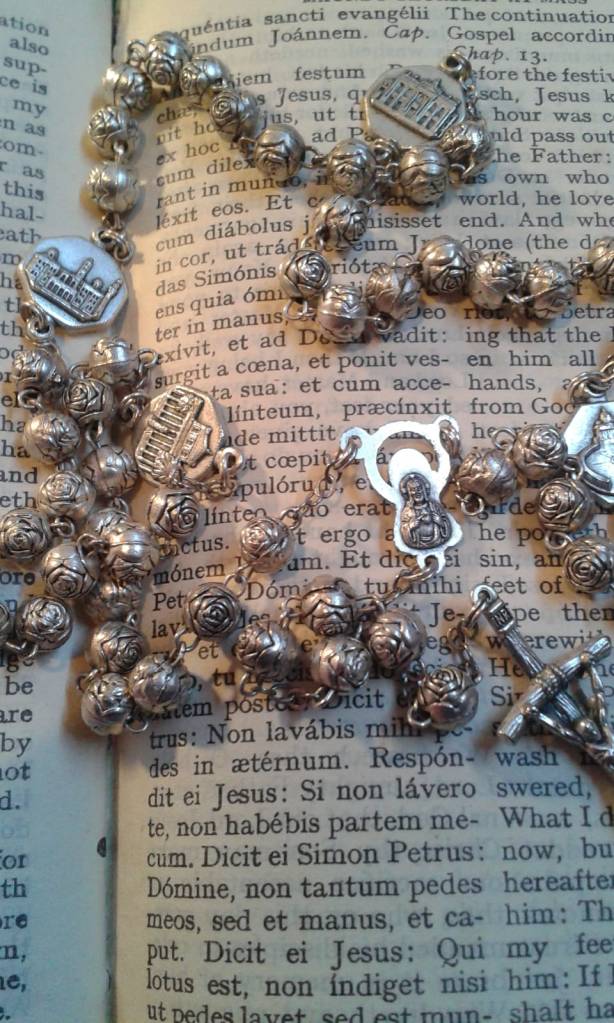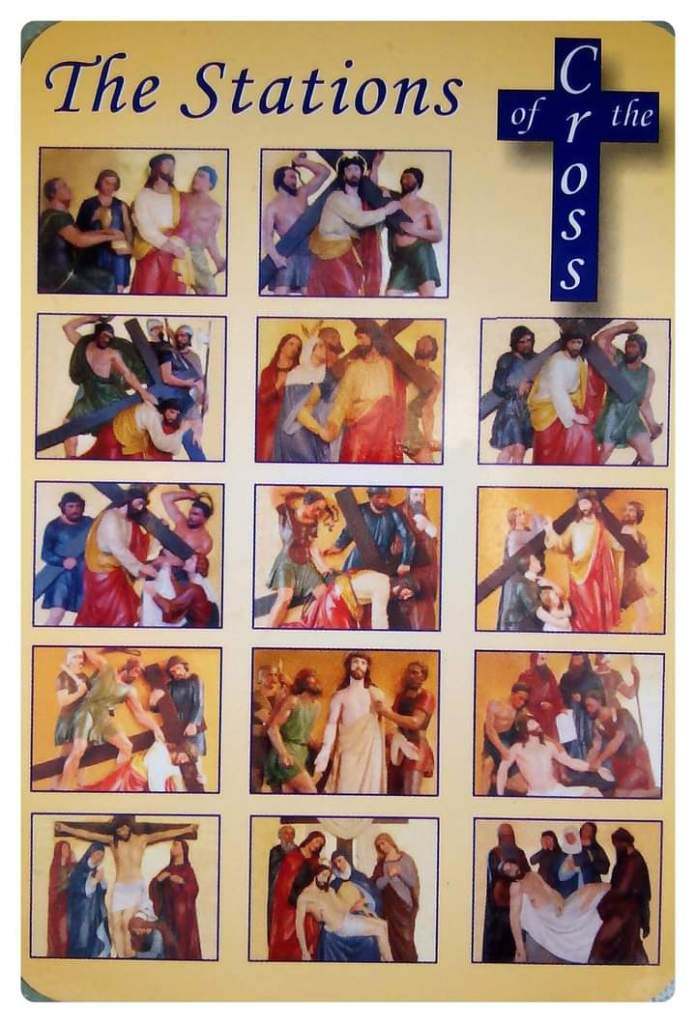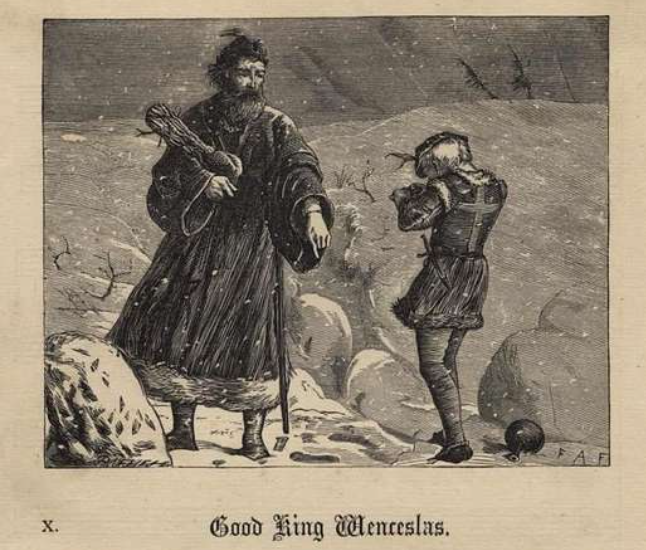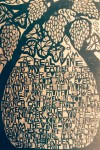“This John, about the sixth year (1564) of her Majesty’s reign (Queen Elizabeth I) that now is, for professing the Apostolic Catholic Roman Faith was imprisoned first at Chester, then sent to the Marshalsea, then to York Castle, then to the Blockhouses in Hull, then to the Gate house in Westminster, then to Broughton in Oxfordshire, then twice to Ely in Cambridgeshire. And so now at 73 years old and blind, he is bound to appear, and to keep within five miles of Towneley, his house, and who has since the statute of 23 Elizabeth (1581) paid unto the Exchequer £20 a month for not going to the Protestant church and doth still; and there is paid already above £5,000.”
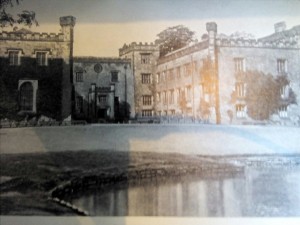
Towneley Hall, ca. 1923
TOWNELEY HALL AND BURNLEY
“Even previous to the so-called Reformation, Towneley Hall and its family had considerable influence in Lancashire, for in 1454 Richard, Bishop of Lichfield, granted licence to John Towneley for an Oratory and Mass at Towneley during the Bishop’s good pleasure. One of the first chaplains was Rev. Richard Parker: whilst in 1481 the Abbot of Whalley asked Richard Towneley to appoint Rev. John Green as chaplain in the place of Richard Parker, lately deceased.
Ye Chronicles of Blackburnshire
In 1590, Towneley Hall figures on Lord Burghley’s map as a marked house, indicated by the cross on it, as a sign that the Towneley family, for its fidelity to the Catholic Faith, was to be wiped out by fines and imprisonments.
For remaining faithful Catholics, the family was to be wiped out by the government with fines and imprisonments
These severe measures continued for fully two centuries, yet at the end of that period the family emerged into a state of opulence never dreamed of by the Townley of 1450, whilst their defence of the Catholic Faith was recognised as the chief cause, under God, that the old Faith was still preserved, and was able, between the years 1800 and 1900, to blossom forth with such wonderful vigour. We are fortunate in having for all this period the history of the late Rev. R. Smith, to whom the present writer readily acknowledges his indebtedness. This [article] on Townley is almost entirely condensed from Ye Chronicles of Blackburnshire.
Each stone of the Chapel was marked
The chapel, which the aforesaid priests served, was originally on the second floor. Until the year 1700, the front of Towneley Hall consisted of this chapel and library. Charles Towneley removed the chapel and sacristy to their present position. Each stone was marked, and everything removed with religious care and reverence and rebuilt on the present site. On the beautifully worked door of the confessional to the right of the altar, there is the date 1601, and the initials of John Towneley, of Richard, his son, and of the Confessor. The public entrance to the chapel was from the back up some steps, and though the door is now walled up, the mark of the stairway outside can still be seen.
In this chapel hundreds of our Catholic forefathers, under varied conditions and great fears, have heard Mass and received the sacraments
Regarding the chapel itself, which one cannot visit with feelings of deep affection and devotion, it measured 33 feet in length and 18 feet in width. About one-third of the length formed the chancel and the rest was the have. It is 12 feet high with a flat ceiling, composed of elaborately moulded oak beams and joists; but the chancel portion is double this height, thus affording room for a good altar and fine reredos, over which was a window. The entrance door to the chapel was handsomely carved, and to the north-east side of the chapel was the entrance to the small priests’ room, or vestry. In this chapel hundreds of our Catholic forefathers, under varied conditions and great fears, have heard Mass and received the sacraments; for long years in penal times it was the centre of Catholic life in the North of England. It served Catholics for many miles round, till, in 1817, Burnley Wood Chapel was built, and after that it continued as the family chapel till about 1895.
These holes were the only sources of light and air to the imprisoned priest in the hiding-place
In the Hall there are now two hiding-places: the larger and better-known one is situated at the south end of the central hall. The entrance to it is through what is really the ceiling of this secret chamber, the floor of which is composed of daub, a mixture of clay and rushes. This material would no doubt be selected in order to prevent any sounds being heard from the hiding-place: it measures 18 feet by 15 feet and 6 feet high, which is very large for a hiding ‘hole’, as they used to be called. In the walls are four holes, about 9 inches square, almost right through the masonery. My guide suggested that these had been made by inquisitive visitors, who were probing for further secret chambers; but I pointed out to him, that so far from this being the case, these holes were as old as the main walls themselves. Each hole is built of square stones until within a few inches of the outside, when the opening has evidently been closed up from outside. These holes were the only sources of light and air to the imprisoned priest, and thus they played a most important part in the designing and building of the room. But when the chapel was moved to its present site and a new priests’ hiding place was made, these holes were closed up from the outside. The second hiding-place was only discovered a fortnight before my visit in August, 1923. It measures 6 feet by 5 feet and is 4 to 6 feet high, being situated immediately above the sacristy and alongside the present chapel.
A fascinating discovery – preventions in case of a government raid (removing all traces of Holy Masses)
A very quaint paper was recently published in the Burnley Express, August 1, 1923. It had been sent to the Mayor of Burnley by Lord Abingdon, whose first wife was Caroline, daughter of Charles Towneley. It is here given in the original spelling.
A NOTE OF THE PRIVATE PLACES AT TOWNELEY.
In the library over against the closet door the middle panell slides back, and the same over against the window. On the floor over against the door, the base slides up and takes out; in the floor is a hole, in which an iron hook is to be put, and will open to a large place by lifting up the whole floor.
At the back side of the library door, the side wainscote may be taken out, and lets you into a place, where some boards may be taken up, which will let you into a large place, which held all the library books: at the chapel door taking up one board, which is not nailed fast, will let you into such another.
In the chapel the altar table draws out, and also the upper steps, which will let you into a large place, in which may be laid all the guilding, which is only put on with pegs, and takes to pieces: care must be taken not to knock the gilding in taken down or putting up.
Over the cannopy of the altar in the library lies a door for the tabernacle balls for the top of the pillars, instead of the flower pots, and also capitals and bottoms instead of the gilding, so that the place may be made use of though the gilding be taken down.
At the steps going from the stone stairs to the garret a step may be taken out, where there is a large place all over the green parlour. In the second room in the gallery the wainscote opens in the middle of the chimney upon hinges, where there is a hole in the wall not very big.
In the third room in the gallery is the close stool closet, the pannel towards the garden has a latch within, which is opened with an iron pin at a hole in the door, which lifts up the latch, which may be made faster by those within: it has a seat and will hold two persons.
No servants should be trusted with this, but upon some occasion some trusty servant may be made use off for some of the places to be used, but not made acquainted with them all.
Copied from a paper found in 1793 in my father’s pocket book and wrote by my great I grandmother, Ursula Towneley; she was D (daughter) of Fermor of Tusmore in Oxfordshire. C.T.
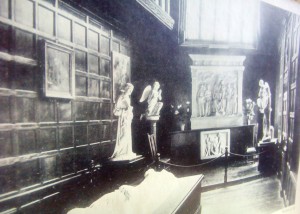
The Chapel at Towneley Hall, ca. 1923
Before 1700 or after?
Her marriage took place in 1685 and her husband died in 1711, so that it is difficult to determine whether the note refers to the house before the alterations of 1700, or after. Then, again, extensive alterations have taken place since the Hall became the property of the Burnley Corporation. For, to make the two long galleries for which the upper storeys of the fine old castle-like building are now famous throughout the country, dividing walls had to be taken down and other changes made, whilst at different times there have been numerous alterations carried out elsewhere.
The Catholic prisoners had to bear the cost of their own food and lodging during imprisonment, and that at extortionate rates
Of the different members of the family who suffered for the Catholic Faith, the first in the long list is John Towneley, of whom a contemporary account says: ‘This John, about the sixth year (1564) of her Majesty’s reign (Queen Elizabeth) that now is, for professing the Apostolic Catholic Roman Faith was imprisoned first at Chester, then sent to the Marshalsea, then to York Castle, then to the Blockhouses in Hull, then to the Gate house in Westminster, then to Broughton in Oxfordshire, then twice to Ely in Cambridgeshire. And so now at 73 years old and blind, he is bound to appear, and to keep within five miles of Towneley, his house, and who has since the statute of 23 Elizabeth (1581) paid unto the Exchequer £20 a month for not going to the Protestant church and doth still; and there is paid already above £5,000.’ This fine, says Father Smith, was only one of the many which he had to pay; the Catholic prisoners, moreover, had to bear the cost of their own food and lodging during imprisonment, and that at extortionate rates.
Binding them in London, away from their family, friends and acquaintances
In 1584 the Privy Council states that Dean Nowell – one of Elizabeth’s commissioners – had requested that John Towneley, committed at Manchester for not conforming in matters of religion, and now fallen into certain diseases, might be suffered to repair to London to consult with the best physicians. The Council directed Mr. Towneley to be sent up in the company of some trusty person, so that he may not be suffered to go out of the way to any house than the ordinary inns. At the same time the Council decided that ‘both Sir John Southworth and Mr. Towneley having paid their fines according to the law, cannot be longer imprisoned, for that would be a double punishment for one offence.’ The Council thought them at liberty more dangerous in Lancashire, where they greatly allied and friended, than in London, and therefore it was better to bind them to remain in the Metropolis.
More sequestrations
Another notable member of the family, from the Catholic point of view, was Richard Towneley, who was born at York in 1628. He became famous as an astronomer and mathematician. He sold the Nocton estates to repair the heavy fines and losses entailed upon his estates by the sequestrations of the Commonwealth. Of his children, Thomas became a secular priest, and served for some forty years on the Lancashire Mission – namely, from 1693 to 1733. Five more of his children embraced religious life on the Continent. John became a monk and Richard a Carthusian at Nieuport; Margaret and Cicely became nuns at the English Augustinian Convent, Paris; of these, Margaret was born at Towneley in 1664, and took the veil in 1683, became Subprioress in 1714, and died in 1731. Cicely was born at Towneley in 1676, took the veil in 1695, and died in 1728. Frances, their sister, married, but, being left a widow, she, too, entered the same convent as a boarder in 1719, whilst her daughter Elizabeth became a nun at Cambrai in 1712.
Richard Towneley, the father, along with Edward Tildesley, took a prominent part in the Rising of 1715. They were imprisoned, and would have lost their lives, but so great was the horror created by the barbarous way in which the other condemned prisoners had been executed, that the jury accepted the plea of Towneley and Tildesley – that what they did had, in a manner, been forced upon them – and acquitted them.
How greatly the fines for recusancy and loyalty had reduced the fortunes of this once great family may be judged from the following letter of Richard Towneley, dated February 12, 1716, to Mr. Richard Starkie, at his Chambers in Furnival’s Inn, London:
Sir,
Yours received, and I must beg you will not fail going as soon as you receive this to the Commissioners and acquaint them that Thomas Hilton came this day along with an Attorney and two Bailiffs and took forcible possession. I desire they will give me orders per the first, what I shall do, for they threaten to sell the small goods I have procured for my poor children and throw them out of doors within a few days. Dear Sir, I beg you will not fail me in this by the very first, and you will ever oblige,
Your Humble Servant
RICHARD TOWNELEY.
Unless they renounce their faith, they inherit nothing, because their late father was Catholic till the end
That the measures of repression after the Rising fell especially heavy on the Catholics is shown from the following letter from the Sheriff of Lincoln. Mrs. Towneley was a daughter of Lord Widdrington.
‘May it please your Honours, in obedience to your Honours’ precept I made enquiry… after the Widdringtons to receive their goods at Blankney House, and all has been sold except these few… the only item is a large table in the hall, supposed to be an heirloom. The family of the late Lord Widdrington are to receive nothing out of his immense estates, because their father was a Catholic, unless every child shall be educated in the Protestant religion, and orders were given to one of the principal Secretaries of State that he might proceed to sell their estates.’
These were sold in 1729, and realised the enormous sum for those days of £96,525.
How closely the Towneley were associated with the Royal Stuart family is seen from the prominent part two members took in the Rising of 1745. Sir John Towneley, a great and learned scholar, was tutor to ‘Bonnie Prince Charlie,’ and took part in the campaign of 1745-46. After the Battle of Culloden he escaped to France, and long kept up his friendship with the Prince and his brother, the Cardinal Duke of York. Sir John died in London in 1782, aged eighty-five.
They were publicly butchered by the common hangman in London
Francis Towneley became Commander of the Manchester Regiment. He was the bravest and most faithful to his Prince of even those devoted followers, and defeated Carlisle till forced to capitulate. Contrary to the written promise of William, Duke of Cumberland, Towneley and other Lancashire gentlemen were tried and found guilty of treason. They were publicly butchered by the common hangman in London, and the horrible injustice of their death heaped additional unpopularity on George II. Towneley’s fate became the theme of the following popular ballad – William being, of course, the Duke of Cumberland.
Towneley’s Ghost
The bloody axe his body fair
Into four partes cut,
And every part and eke his head
Upon a pole was put.
When the sun in shades of night was lost
And all were fast asleep,
In glided Towneley’s murdered ghost,
And stood at William’s feet.
‘Infernal wretch, away,’ he cried,
‘And view the mangled shade,
Who in thy perjured faith relied
And basely was betrayed.
Embraced in bliss, embraced in ease,
Tho’ now thou seem’st to lie,
My injured shade shall gall thy ease
And make thee beg to die.
Think on the hellish acts you’ve done,
The thousands you’ve betrayed;
Nero himself would blush to own
The slaughter thou hast made.
No infants’ shrieks nor parents’ tears
Could stop thy bloody hand;
Not even ravished virgins’ tears
Appease thy dire command.
But oh, what pangs are set apart
In hell, thou’lt shortly see;
When even all the damned will start,
To view a friend like thee.’
With speed, affrighted William rose
All trembling, wan, and pale
And to his cruel sire he goes
And tells the dreadful tale.
‘Cheer up, my son, my darling son,’
The bold ursurper said;
‘Never repent of what you’ve done
Nor be at all dismayed.
If we on Stuart’s throne can dwell,
And reign securely here,
Thy uncle Satan’s King in Hell,
And he’ll protect us there.’
Charles Towneley – He never neglected his duties as a faithful Catholic
Charles Towneley, nephew of the above [Francis Towneley], was born in 1737, and succeeded to the estates at the age of five. At ten years of age he was sent to the English College, Douai, and thence to Paris. Later he resided much in Rome, and made a magnificent collection of statuary, which he playfully called his ‘dead family.’
He acquired a European reputation, yet he never neglected his religious duties as a faithful Catholic, nor his obligations to his friends at Burnley. He regularly spent some months of every year at Towneley Hall, embellishing its grounds, and forwarding the interests of its people. Dignified, amiable, cheerful and accomplished, untiring in his care of his tenantry and the poor of his estates, a splendid cultivator of the beautiful, the figure of Charles Towneley appeals to the imagination as that of an ideal Englishman of the eighteenth century. (Father Smith, p. 182.)
After his death in 1805, the British Museum acquired his collection, which now forms one of the very greatest treasures of our National treasure house. ‘In a general way, Lancashire is thought of chiefly as a county which has made important contributions to machinery and manufactures. It is pleasant to remember that for the enjoyment of such works of art as the Capitoline Venus, and other beautiful and noble sculptures, which compose the Towneley gallery, the thanks of the nation are due to the taste, energy, enterprise and liberalities of a Lancashire Worthy, Charles Towneley.’ (Lancs. Worthies, II Series, p. 200.)
Great is Truth, and it will prevail
Peregrine Towneley, born in 1772, succeeded in 1813, gave the land for the Burnley Wood chapel, and himself contributed £1,000 towards the building. In 1831 he was made High Sheriff of Lancashire, an office held by his ancestor John Towneley in 1532. Stirring times had indeed filled those past three centuries, but the family had been true to the motto ‘Tenez me Vraye’ (‘Hold the Truth’) and certainly few better examples could be found in the renewed prosperity of the family in the nineteenth century of another: ‘Magna eat Veritas et praevalebit’ (‘Great is Truth, and it will prevail’).
What do we know of the priests of Towneley and Burnley?
Of the priests who successively attended the Catholics of Towneley and Burnley, Robert Woodruff entered the English College, Rheims, in May, 1577; he was ordained in Rome, 1582, and sent to England along with John Nutter and Samuel Conyers. In 1586 ‘It appeareth that Robert Woodruff, a seminary priest, was received at the house of Janet Woodruff, of Bank Top, in the parish of Burnley, this half year, by common report.’ In 1590 he was arrested again at Crosby Hall, and imprisoned along with his host, Mr. Richard Blundell, who died in prison the following year. In 1603, after thirteen years’ imprisonment, Father Woodruff was reprieved and sent into exile, as reported in the Douai College Register, and after that he is lost sight of.
Father William Richmond, after his escape from York Castle, lived with the Towneleys at Towneley Hall, where he probably died in the first quarter of the seventeenth century.yer. Gillow says that he searched in vain for Father Richmond’s burial notice at St Peter’s, Burnley, and he thinks that Burnley, and especially Towneley, were too closely watched for this priest to be able to stay here long without being recaptured, so nothing more is known of him (p. 131).
Some of the district’s martyrs’ biographies
But constancy to the Old Faith was not confined to the squire and his family: the yeomanry and peasantry of the district were just as staunch. No less than three martyrs are most closely connected with the district.
Hang, drawn and quartered at Tyburn, London
Of these, the first in order was John Nutter, born at Reedley Hallows, Burnley, who entered the English College, Rheims, in 1579, and was ordained in 1582. He came to England intending to land at Scarborough, but the ship foundering upon the coast of Norfolk, Mr. Nutter was put on shore at Dunwich. He was at once arrested and sent to the Marshalsea, in London, and the following year, 1584, he was tried and condemned with four other priests. After lying in irons five days in the Tower, he was drawn, together with the same four confessors, to Tyburn, and there hanged, cut down alive, bowelled and quartered.
He was prisoner in the Tower of London as early as 1583, and was tortured
The second martyr was Robert, brother of the above, who was ordained priest in 1581, and in the following year came on the English Mission. He was a prisoner in the Tower as early as 1583, where he was twice tortured with the ‘scavenger’s daughter’. He was banished in 1585, but returned, and was again imprisoned. Escaping with Venerable Edward Thwing, he was rearrested in Lancashire and executed at Lancaster, July 26, 1600, solely on account of his priesthood. (Challoner.)
He openly acknowledged that he was a priest, and as such was sentenced to death
The third martyr was Thomas Whitaker, born in 1611 at Burnley, where his father was schoolmaster. At the age of twenty-three he went to the English College, Valladolid in Spain, the Towneleys paying the expenses of his journey. He was ordained in 1638, and at once came on the English Mission. He exercised his priestly functions with great zeal for five years, until he was seized and committed to Lancaster Castle. Thence he escaped, only, however, to be captured again in 1643, when he was again imprisoned in Lancaster. After three years of most holy life in prison he was brought to trial, when he openly acknowledged that he was a priest, and as such was sentenced to death. He suffered at Lancaster, August 7, 1646, in the thirty-third year of his age and the eighth of his mission. Further details of his life may be read in Bishop Challoner’s Memoirs of Missionary Priests.
The number of those confirmed shows that many of the old Catholics still survived
In 1661 Rev. Peter Gifford came to be Chaplain to the Towneleys. In 1675 he was Secretary of the famous Lancashire Infirm Clergy Fund, and in 1682 was elected Vicar-General of the North. He died, aged sixty-six, in 1689, at Towneley Hall, where he had probably found moderate security under the protection of the family. During his stay at Towneley, Bishop Leyburne held a great confirmation there. King James II. had come to the throne in 1685, and had heartily welcomed the Bishop, lodging him in Whitehall, and granting him a pension of £1,000 a year. There would be much rejoicing at Towneley when the good Bishop came, and the number of those confirmed – 203 – shows that many of the old Catholics still survived. Burnley at that time was only a small town.
Pre-reformation vestments, perhaps originally from Whalley Abbey
Father Thomas Anderson, born in 1675, of the Euxton family, was the next priest. He was ordained in 1702, and in 1705 came to Towneley Hall and lived with the family. His record of baptisms, marriages, and stipends of Masses still exists. After the Stuart Rising of 1715 he was convicted as a recusant at the Lancaster Sessions, when he was described as ‘one Anderton, a reputed Popish priest at Towneley.’ That year he received from Mrs. Ursula Towneley £10 for the half-year, his annual salary being £20. Father Anderton’s notebook was sold at the last dispersion of the Towneley Hall library, and became the property of the Burnley Literary and Scientific Society, while at a still more recent date (1922) the Burnley Corporation secured the very valuable pre-Reformation vestments, which are now on exhibition at their old home, Towneley Hall. It is said that these beautiful vestments originally belonged to Whalley Abbey.
Father Anderton spent the whole of his missionary career at Towneley. He was greatly respected by his patrons, and esteemed by the numerous Catholics who formed his congregation. He was a member of the Old Chapter, and in July, 1732, was elected Archdeacon of Lancashire. He closed his days peacefully at Towneley, July 13, 1741, aged sixty-six.
He was succeeded by Rev. George Kendal, who also succeeded him as Archdeacon of Lancashire. At this time Towneley was the centre and headquarters of the secular clergy, the archdeacons, and later the vicars capos topic, residing there. In 1744 Dr. Kendal resigned the Mission of Burnley and Towneley to take charge of that at Fernyhalgh.
Rev. John Harrison, born at Cottam in 1714, was priest there in 1746, when his house and chapel were burnt down by the fanatical mob from Preston. Father Harrison removed to Towneley and served that Mission for thirty-one years, until he was no longer able (1746-1777). He then went to live with his brother in Preston, and died there in 1780. At this period (1773) Bishop Petre reported to Propaganda that there were sixty-nine residences for priests in Lancashire, and that the Catholics numbered 14,000. The following year Bishop Walton confirmed at Burnley, but the numbers – only thirty-nine – seem to show that the Catholics had been dwindling under the bitter persecution of those times. In 1784 Bishop Mathew Gibson confirmed twenty-five at Burnley.
Dear to God and the poor
Rev. Thomas Caton was priest from 1785 to 1811. He gathered together the various registers which begin in 1705, and which he himself continued till 1809. He was succeeded by Rev. Louis Merlin, whose epitaph may be seen in St Peter’s churchyard, Burnley, as follows: ‘There rests here, dear to God and the poor, Rev. Lewis Merlin, who, an exile from his home in France, first in Scotland, then in England, gave himself to works of piety and charity; at length, broken down by his arduous labours, he died at Towneley December 12, 1819, in his fifty-fifth year.’
Father Charles Lupton came to Burnley in 1819, and died at Towneley five years later. Previous to his death, Father – later Canon – Hodgson came to relieve him, and remained twenty-five years. In 1824 the Easter communicants numbered 116, and in 1825 150. In 1829 Burnley Wood Chapel was enlarged, and in 1849 it was replaced by St. Mary’s, which was opened amidst great rejoicings, Cardinal Wiseman being the preacher of the day.
The opening of St Mary’s Catholic church after centuries of suffering
But bigotry was still very rife in Burnley; the town was flooded with a most sacrilegious poster, and the walls of the town were plastered with ‘no popery’ placards; the exterior carvings round the church were greatly damaged, and the statue of Our Lady, within a niche of the church, was often shot at, but was never hit. St Mary’s Bazaar Book of 1902 truly says: ‘It is a far cry now to the time when, in 1817, the first Catholic church was built in Burnley Wood. Up to that time the chapel in Towneley Hall had been from time immemorial the only place of worship for miles round. It seems difficult to realise that, when the little Burnley Wood chapel was built, it was the only one for Burnley, Todmorden, Bacup, Colne, Barrow Ford, Nelson, Brierfield, Lowerhouse, and Padiham. Now all these places have churches of their own, whilst in Burnley itself we have four churches where our grand old Catholic Faith is practised.’
Witness of the piety and sufferings of past generations
Towneley Hall, in consequence of mining and other industrial operations, became quite unsuited for a private residence, and was sold to the Corporation of Burnley in 1902. In the following year it was opened as an art gallery and museum, so that may of our readers will be able to see round it, and to visit the chapel and priests’ hiding places, witnesses of the piety and sufferings of past generations which have borne such fruit in our own happier times.”
– Dom F. O. Blundell, O.S.B., Old Catholic Lancashire, Volume I, Burns Oates & Washbourne Ltd., London, 1925
